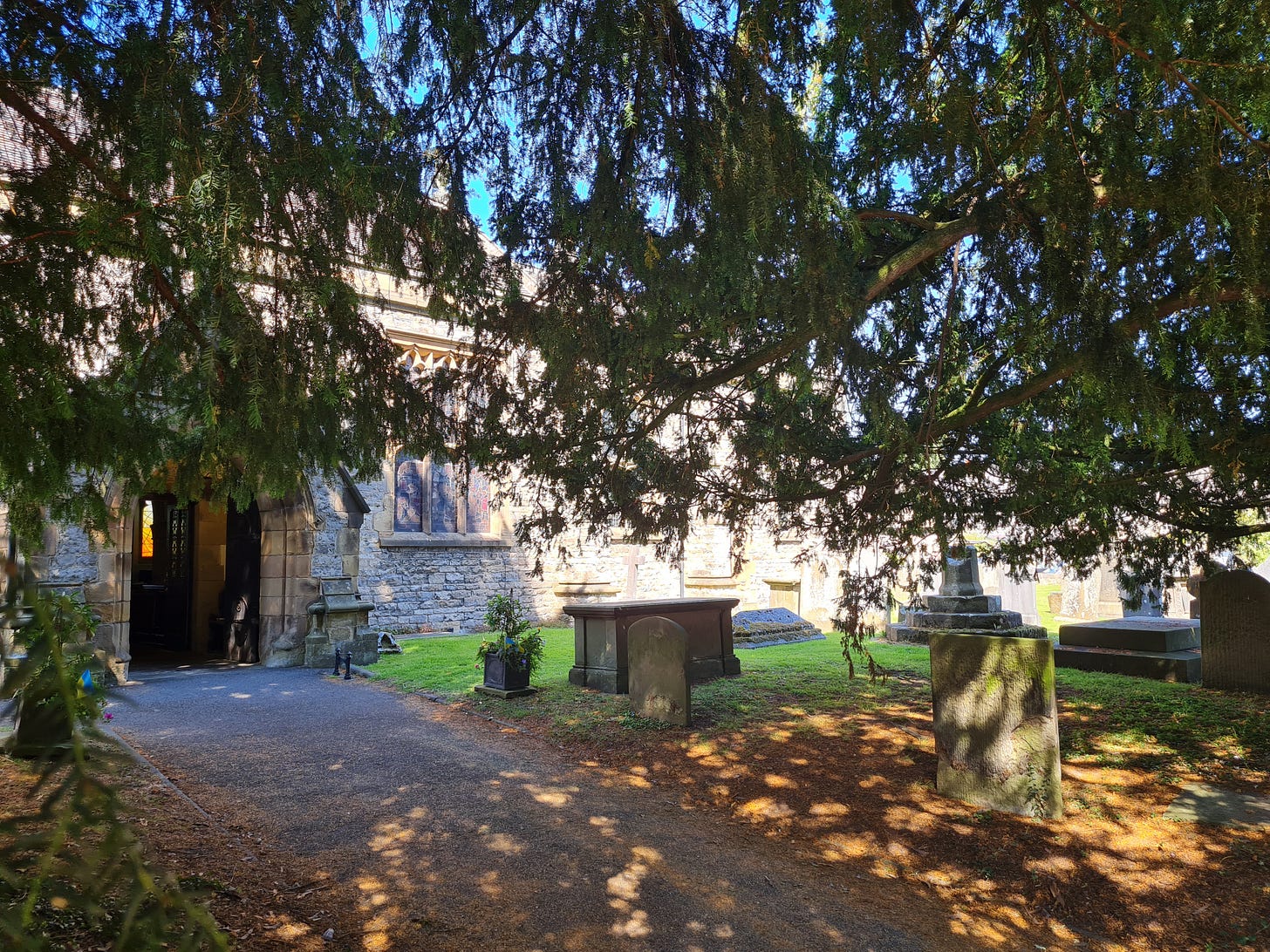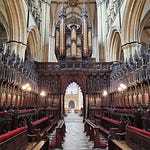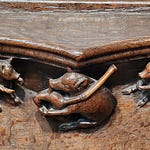I’m continuing some extracts from an interesting book on history and legends of churches. For those who like to listen, I’m providing an audio version. Please forgive my oddities of accent and pronunciation!
For those who, like me, prefer written form, here is a transcript.
Lore and Legend of the English Church by George S. Tyack, Chapter 2, Part 1,
The Churchyard
From the earliest times it was usual, when possible, to have a garth or enclosed space about a church, although it was not at first used for burials.
Instances of interment within the sacred precincts occur in the 4th century, and by the 6th the practice had become common. Cuthbert, who ascended the primatial throne of Canterbury in 742, has been credited with introducing the use of churchyards as burial places into England. One of the laws of the King of Wales in 943 prescribes the extent of such an enclosure.
“The measure of a burial ground is a lawful acre in length, the extremity of which shall touch the threshold of the church and surround it on every side.”
The earliest English allusion to this hallowed spot is in the excerptions of Egbert, Archbishop of York, issued around 740, where, under the name of “Atrium”, it is mentioned as a garden near the church.
The planting of churchyards with trees is a custom the origin of which has often been discussed, especially as certain trees appear to have been held, time out of mind, as specially sacred to such use.
The yew is before all others the typical churchyard tree of England, and the possible reasons for its frequent appearance there are well summed up by White in his Antiquities of Selborne, in a passage which is worth quoting at length.
“Deborah, Rebecca's nurse, in Genesis 35, verse 8, was buried under an oak tree. the most honourable place of interment, probably next to the cave of Machpella, which seems to have been appropriated to the remains of the patriarchal family alone.
The farther use of the yew trees might be as a screen to churches by their thick foliage from the violence of winds. Perhaps also for the purpose of archery, the best longbows being made of that material. and we do not hear that they are planted in the churchyards of other parts of Europe where longbows were not so much in use. They might also be placed as a shelter to the congregation, assembling before the church doors were opened, and as an emblem of mortality by their funereal appearance.
In the south of England, every churchyard almost has its tree, and some too, but in the north, we understand, few are to be found. The idea that the yew tree afforded its branches instead of palms for the processions on Palm Sunday is a good one and deserves attention.
The idea of protecting the fabric of the church by means of surrounding trees occurs in one of the decrees of the Synod of Exeter held in 1287, which runs...
“Since trees are often planted there in the churchyard to prevent the church from being injured by storms, we strictly forbid the rector to fell them. Unless the chancel shall stand in need of repair, or unless, when the nave requires to be repaired, the rector, on account of the poverty of the parishioners, shall think proper out of charity to grant them some of the trees for that purpose.”
There is evidence that the churchyard used was sometimes used for making longbows, but it is by no means so certain that they were planted there for that purpose, although their growth there with that object was encouraged by Edward IV about 1470. Indeed, the fact that the trees in each churchyard were never numerous, while the number of bows required at the time when the longbow was the national weapon must have been very large, coupled with this other fact that the best wood for bows came from abroad, seems fatal to the theory.
The yew, however, was unquestionably the usual wood for the manufacture of bows. And to this, and to the poisonous nature of the leaves, Shakespeare alludes when he makes Scroop say, in King Richard II, Act 3,
“the very beadsmen learn to bend their bows
of double fatal yew”.
And among the accounts of the church wardens for the parish of Ashburton in Devon, we find such entries as sums received from lopping off the yew tree, and payments for to the Bowyer in 1558-59. But in the days of Elizabeth, a bow of English yew cost but two shillings, while one of the best foreign yew cost six shillings eightpence. Spanish wood was then, rather strangely, considering the regulations of the two countries at that time, the most highly prized.
That yew was used in the Palm Sunday procession is also clear. But here again the fact hardly accounts for the frequency of the presence of the tree near the church, for its branches were by no means the only substitute for palm that was employed.
In an old sermon for this festival we find a passage relating to the green leaves taken for the procession. Yew came to be called palm in many places as a result.
An entry in the accounts just quoted, under the date 1558-59, mentions the sum paid to the Bowyer for cutting of the palm tree. As late as 1709, the church wardens of St Dunstan's Canterbury caused a, “palm tree” to be planted in their churchyard.
And the accounts of Woodbury Devon for 1775, refer to a yew or palm tree planted on the south side of the church. But in many places the willow is so named, especially in the north of England, and church wardens' accounts in London frequently allude to the purchase of that and of box, as well as yew, against Palm Sunday.
The appropriateness of the yew to a graveyard has been asserted on the two opposite grounds, that its heavy foliage has long made it emblematic of death, and that its wonderful vitality makes it a type of resurrection and eternal life. It is certain that among the ancients, yew shared with Cyprus the mournful honour of being used at funereal solemnities. and that the tradition of such usage reached to our own country, and almost, if not quite, to our own time.
On the other hand, the life of the tree is extraordinary. At Fountains Abbey are examples which are supposed to have attained their full growth in the 12th century, and a huge tree in Darley Churchyard, Derbyshire, has been variously estimated at from 700 to 2,500 years old. The tallest specimen in England is in the churchyard at Harlington near Hounslow and stands 60 feet high.
There are not wanting antiquaries who, with much reason, consider that the connection between the yew and consecrated ground stretches back to a time before Palm Sunday processions or longbows were thought of. Dr Rock considers that the alliance has subsisted from the days of the conversion of our English forefathers, while others hold that the presence of a noble tree growing in its natural beauty was the occasion of the choice of the site for the church.
Owing perhaps to its close connection with sacred things, the yew is held to be specially hateful to witches, and any place sheltered by it is safe from their attacks. In Cornwall, to pluck branches or blooms from any shrubs or flowers planted in a churchyard is considered unlucky, and it is alleged that ghosts from the despoiled ground will haunt the house of the depredator.
In marked contrast to the somberness and heaviness of the yew is the rose, with its delicate tints and fragile form. But this queen of flowers has also been consecrated to the service of the burial ground. At Ockley in Surrey, it used to be customary to plant roses upon the graves, especially for a maiden, so to adorn the last resting place of her lost lover.
The Synod of Exeter made a decree concerning the grass of the churchyard. the propriety of which, though it will now be almost everywhere admitted, was at one time generally denied or ignored in England. “We decree”, say the Exeter Fathers, “that if the rectors of churches or parish priests, to whom the custody of burial grounds chiefly belongs, shall suffer their own or any other cattle to feed there, they shall be severely punished by their ordinaries.” Until comparatively recently it was quite usual for sheep to be pastured in God's acre, and it is still occasionally done, although every dictate of good feeling and reverence is surely against such usage of ground consecrated both to God and the memory of the dead.
Cows also were sometimes fed there, and milk from animals living in such a pasture was considered in the north of England a sovereign remedy against the ill effects of being witch-ridden.
The belief that churchyards are haunted is natural enough. If spirits walk at all, if anywhere communion is to be held with the souls of the departed, the burial ground is obviously the most likely place for such ghostly perambulations and meetings.
According to one tradition, it was the rule at one time to provide each church and churchyard with a ghostly defender against the spell of witches or their diabolic practices. In order to do this, a dog or a boar was buried alive under one of the cornerstones of the building and its apparition kept off all profane intruders.
In case any person buried in the churchyard is unable to rest but haunts the place at night, the ghost may be laid by cutting a turf at least four inches square from his grave and laying it under the altar for four days.
Cornwall at one time boasted the possession of several priests who were famous as ghost slayers, the Reverend Thomas Flavell being the most noted. His services were in great demand and his methods were of a masterful kind, for he appears generally to have visited the haunted churchyard armed with a horsewhip and to have combined exorcism with vigorous flogging.
It is not very far cry from ghost laying to the question of spells and divination, and churchyard folklore provides several items of information on these matters.
The weird rites of St Mark's Eve, April 24th, are known to most people. On this night, the wraiths of those who are to die during the following 12 months pass in grim and ghostly procession into the church. And he who has the courage to stand in the churchyard, at some spot commanding a view of the porch, from 11 that night until one o'clock the next morning, for three successive years, shall on the third occasion see the prophetic vision. Such was the belief, and it still lingers in some places, although it is not always held necessary to pass a two years probation before the watch is rewarded.
There are many stories, some of them remarkably circumstantial, of this vigil having been kept with the anticipated result. In some cases the procession is alleged to be somewhat more formal, the wraiths of the doomed walking in solemn state around the churchyard preceded by the parish clerk. An old man in the parish of Fishlake, Yorkshire, kept these vigils regularly at the beginning of the present century.
“Some years since, Mr Edward Peacock, the well-known antiquary, communicated to notes and queries the following certified account of one of these vigils, copied from Holly's Lincolnshire Notes. At Axum, alias Haxey, in the Isle, one Mr Edward Vickers, curate to Mr William Dalby, vicar, together with one Robert Halliwell, a tailor, intending on St Mark's even, at night, to watch in the church porch to see who would die in the year following, they, addressing themselves to the business, wished Halliwell to be going before and Vickers would presently follow him.
Vickers fell asleep, and Halliwell, attending his coming in the church porch, forthwith sees certain shapes presenting themselves to his view, resemblances, as he thought, of divers of his neighbours, who he did nominate, and all of them died the year following. And Vickers himself being asleep, his phantom was seen of him also, and he died with the rest. This sight made Halliwell so aghast that he looks like a ghost ever since.”
The testator was a native of Haxey where this took place. It was commonly supposed that if the watcher himself was to die, he fell asleep during his vigil and so would see nothing.
A case is quoted, however, of an old woman who spent St Mark's Eve in the porch of St Mary's Scarborough and who saw her own figure pass in the ghostly train.
There is a curious story of the apparition of a late rector of Ford, Northumberland, one Mr March, being seen by two casual passers-by on this mysterious night. Robed in his surplice, the phantom flitted through the chancel door which opened for him to pass, and having reached a certain point in the churchyard, he vanished. That night the rector was taken ill and died the following day, his grave being dug just where the vision had disappeared.
Next post














Share this post